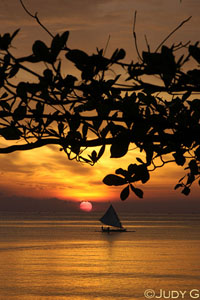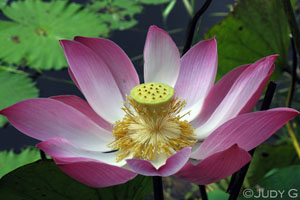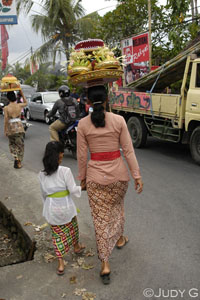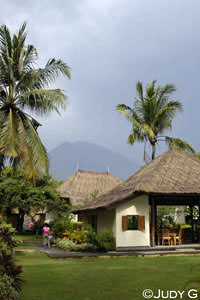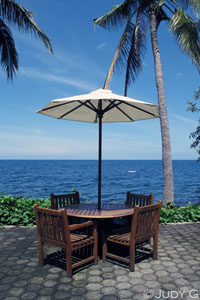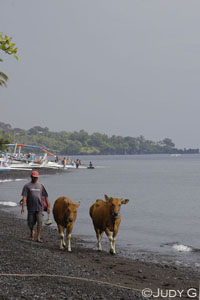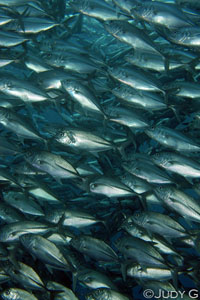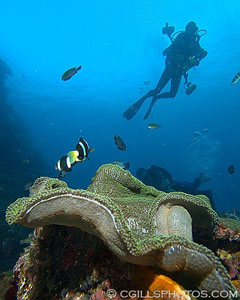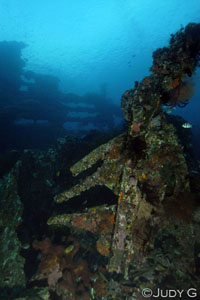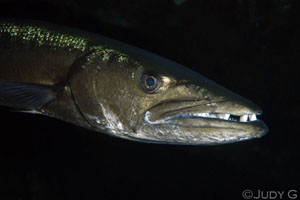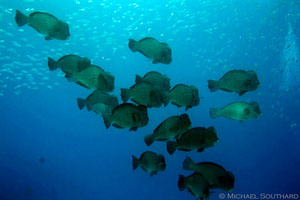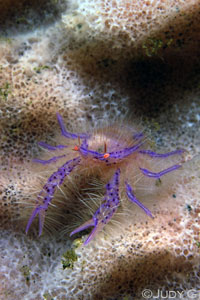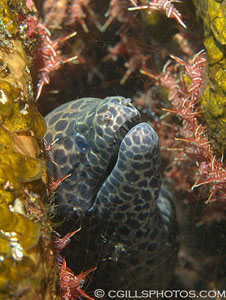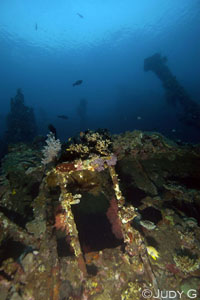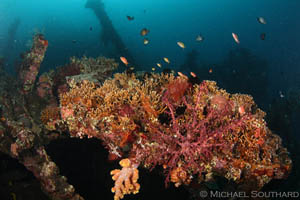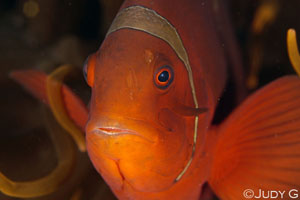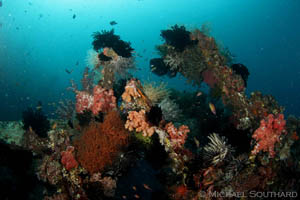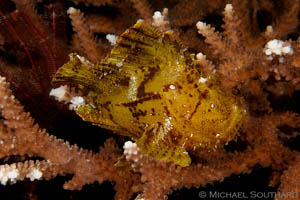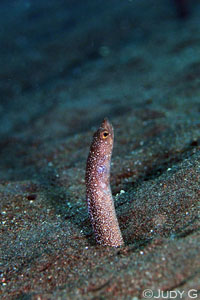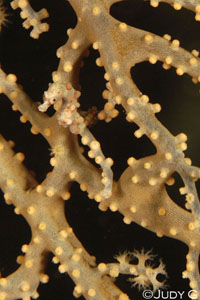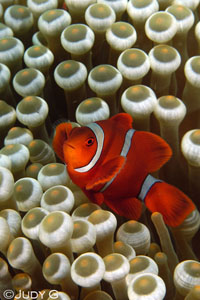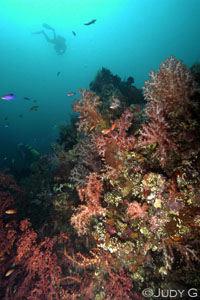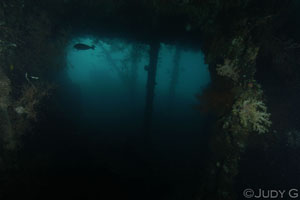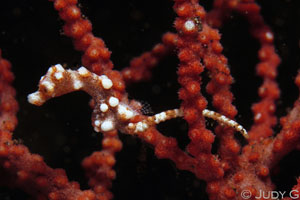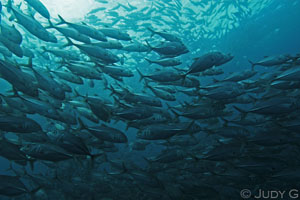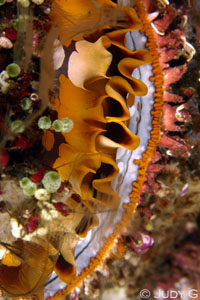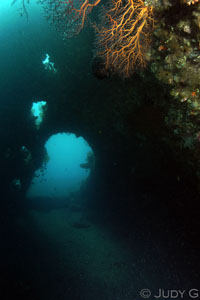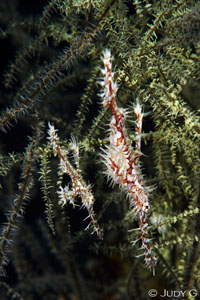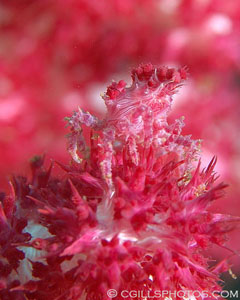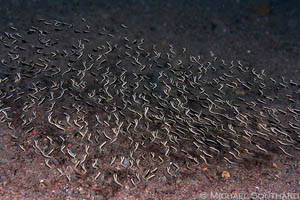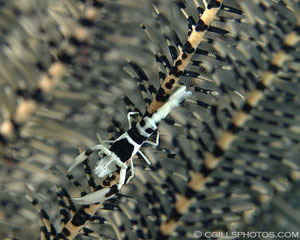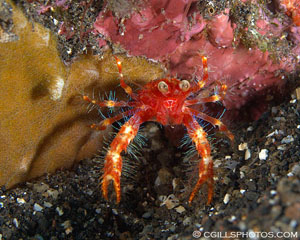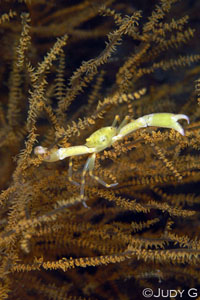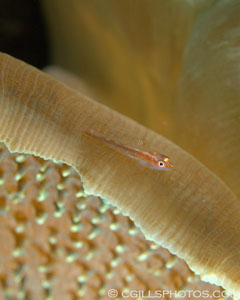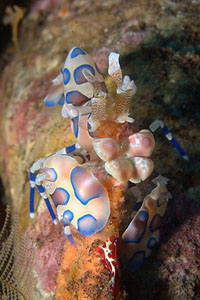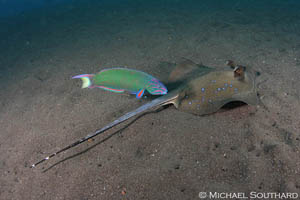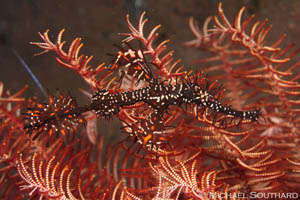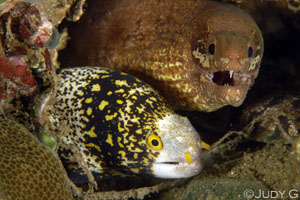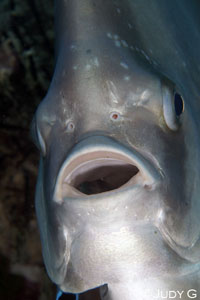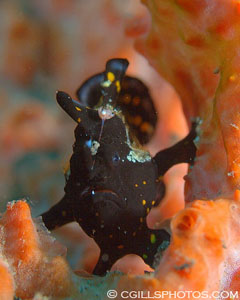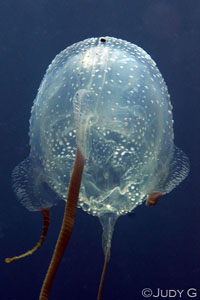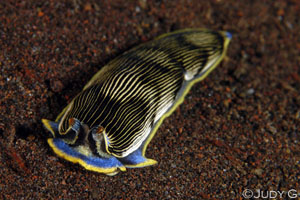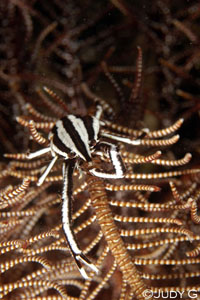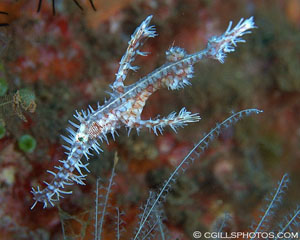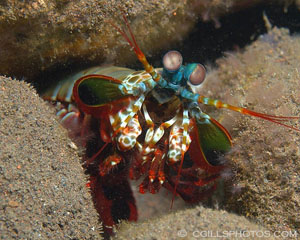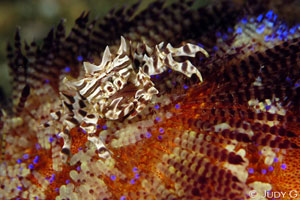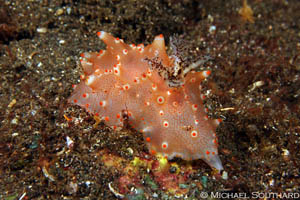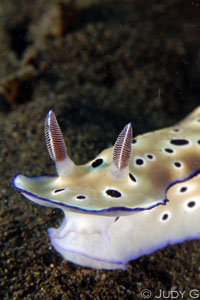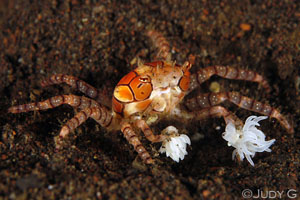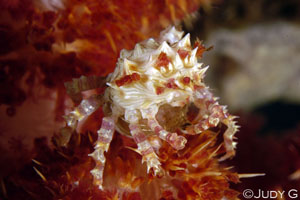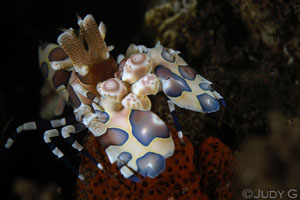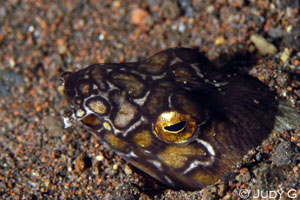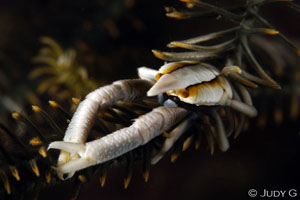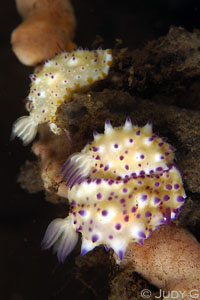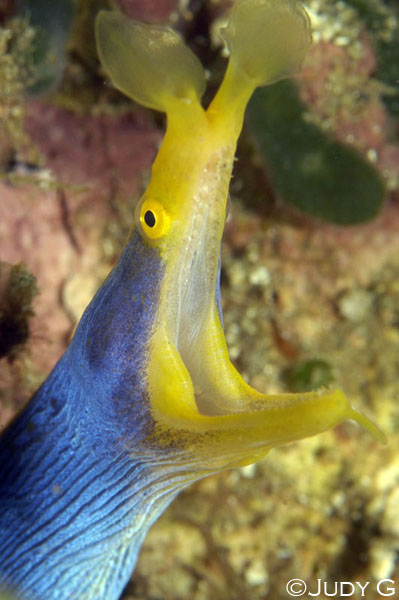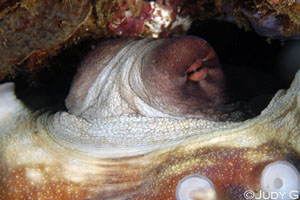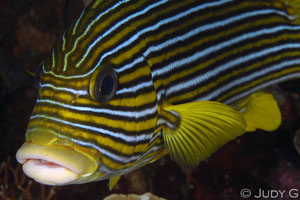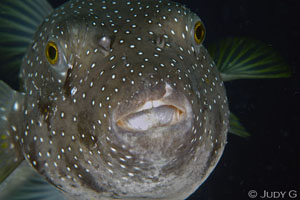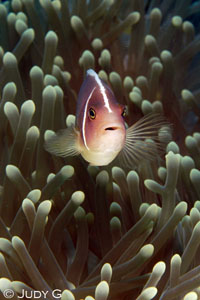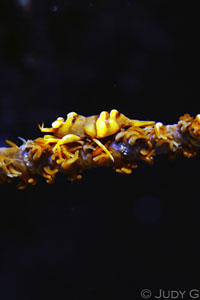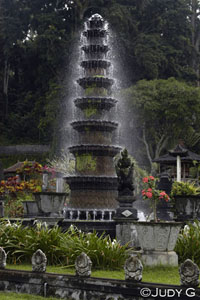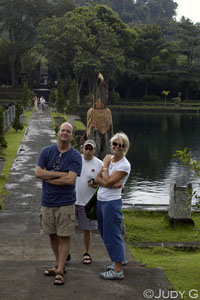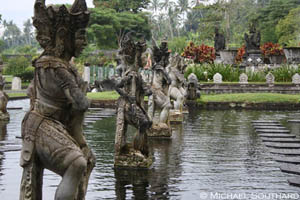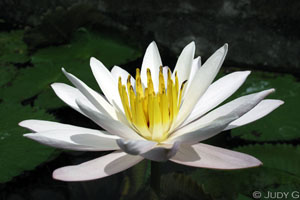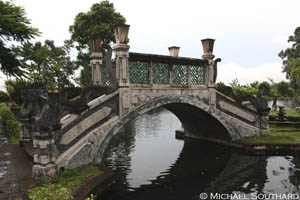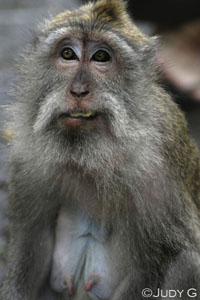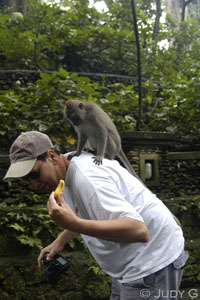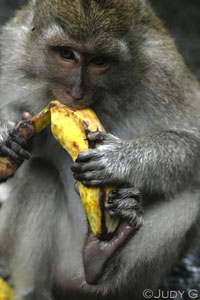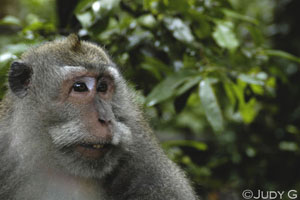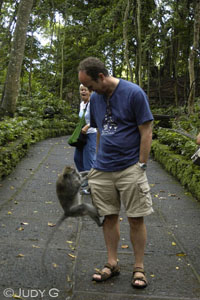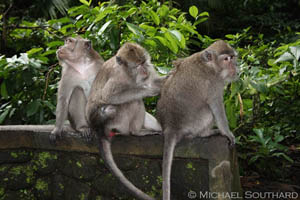Indonesia Immersion
Text by Judy G
Hello Bali! As I mentioned in the Introduction to this epic group effort trip report, Mike Southard, Cindy Abgarian, Mr G and I spent a few days at Scuba Seraya on Bali, before meeting up with a chunk of the group at the Sofitel Resort in Seminayak (a resort town approximately 20 minutes from Bali's Denpasar airport). We spent the night at the Sofitel so as to be close to the airport for our flight out to Ambon to meet the Archipelago Adventurer II early the following morning. The lovely Scuba Seraya Dive Resort is located on the northeast coast of Bali, near the town of Tulamben — approximately a two and a half hour drive north of Denpasar Airport. And what a crazy drive it is. For tourists, renting a car and driving oneself around Bali can only be for the truly insane, er, intrepid ;^). The traffic snarls in southern Bali, and the rules of the road faithfully ignored by the Balinese (not to mention that they drive on the "wrong side of the road" in this part of the world), makes for a hair-raising journey, even in the back of the bus, any time of day or night. In fact, Scuba Seraya's owner himself, Patrick Schwarz, a Swiss ex-pat, was very seriously injured a few years back, just outside the driveway into the resort, when an on-coming truck thought it could get by his small car on a narrow, one-lane bridge (since upgraded to two lanes). He told us that while he lay broken in the local hospital, traffic injuries arrived with almost unbelievable frequency - most often scooter riders, who never win in a physical altercation with another vehicle. Cindy had visited Bali previously, and had stayed at Scuba Seraya for a few days between visits to Wakatobi and Lembeh, and highly recommended it — so much so that she was eager to return. She advised us that the best way to get to the resort was to arrange for the resort's van and driver to meet us at the airport to transport us. Iis (pronounced eye-eese), the Manager of the Scuba Seraya booking office (which is located in the town of Sanur — quite distant from the resort itself), was a most prompt e.mail correspondent in all matters regarding reservations, transport and any other queries regarding a stay at the resort. She was most able and willing to arrange any transfers to get us to and from the airport, as well as arrange an add-on excursion that we requested on our way to Seminayak, at the end of our stay. Anyhoo, so there we finally were, being met by the Scuba Seraya driver (the laconic but kind Alit) at Denpasar Arrivals, a bit exhausted after a long-way-around commute from Canada (traveling in Aeroplan points seats), and having endured the boondoggle that is Indonesian Customs & Immigration (more about that in the Appendix of this report). But, instead of being lulled into a stupor by the beautiful views of the verdant jungle and rice paddies, with glimpses of the glorious Indonesian sea around one bend, and soaring volcanoes around the next, I can tell you that I was on high alert and cringing every time scooters passed us (on the curb side — watch out for those soft shoulders folks!). I was white-knuckled as on-coming traffic leap-frogged around slower moving vehicles by coming at us, with grim determination, head on, in our lane. Did I mention the large population of apparently road-savvy Indonesian small children and dogs, who seem to know exactly when to time their veer off the road so as to avoid becoming roadkill? Aye Carumba! And you thought Mexico was gnarly... Families of four or more stacked onto belaboring scooters, tottering open trucks laden with sugar cane, baskets of fish, school kids, farm workers, goats, watermelons (I think you've got the picture) clog the roads. Horns sounding constantly, not with New York impatience, but as a warning to other drivers that one is about to make a move. The incessant honks and beeps created a Pavlovian response in me — heart rate increase, cold sweat, the occasional gasp of fear — and scored an unforgettable soundtrack for our journey north. Welcome to Asia. As we left behind the more congested areas of Bali, to the south, we transited through farming country — sugarcane plantations, banana plantations and the beautiful, tiered rice paddies that are ubiquitous with the word Bali. Sun, tropical downpours of rain (and so, not surprisingly, rainbows) engulfed us. Late afternoon magic light illuminated the steeples of volcanoes as they peeked out of their shrouds of tumescent clouds. It was glorious. The countryside is dotted with modest seaside resort towns and small villages, huddling up to the main road, front doors opening within feet of the speedy through traffic, with fragrant, smoldering offerings to Hindu gods placed in front of each one. Each dwelling, no matter how humble, has a large stone temple, its base wrapped in a colorful swatch of fabric, prominently on display. Dogs, goats, beautiful children, women in traditional Balinese dress balancing huge loads on their heads (look Ma, no hands!) and legions of Balinese men, shirts rolled up to cool their bellies, sitting, smoking and perfecting the art of doing nothing, all whizzing past us in a visual feast. Yes, Judy, you are not in Canada any more. Finally, in the waning minutes of daylight, we turned down the short driveway to the resort, and found ourselves in the haven of the Scuba Seraya property, being welcomed by Komang, the very accommodating resort Manager, and several of the staff who all hurried out to greet us and to expediently roll our bags out of the mini-bus and into our rooms. A cool fruit drink was immediately offered as we were invited to sit down in the dining area and fill out our dive waivers. You want to dive right away? No problem. Cindy, Dave and I were much too whacked to take them up on it (I was only up for a beer, dinner and a pillow), and Mike was arriving late that evening, but good to know...
Scuba Seraya Resort Scuba Seraya is a small, you might even say intimate, resort, on a spacious and beautifully landscaped beachfront property. The resort offers three levels of accommodation for a maximum of twenty-four guests. Available accommodations are four Oceanview Villas, six Gardenview Maisonettes (by the pool), and four Gardenview Maisonettes (um, by the garden). All are charming, especially the Oceanview Villas, which have a very spacious main bedroom (king bed with mosquito netting), desk, ample clothes locker (including in-room safe) and a large en-suite bathroom (that is actually located outdoors but is covered). The bathroom can be accessed from both the bedroom and the private side courtyard (with lock yourself-in wooden gates). Each of these villas has its own private courtyard featuring a romantic, private outdoor bath (we found it made for a splendid camera-leak-test dunk tank), covered bar area with coffee/tea making facilities and, most wonderful of all, an oceanview daybed, replete with mosquito netting and roll down bamboo privacy shades. The front of the bedroom has french doors leading out to a small sun terrace (with teak deck chairs). From there, there is a small expanse of beautifully-kept garden, and then the sea. The Gardenview Maisonettes are somewhat less luxe, but still very nicely appointed. No courtyard, and no or partial ocean view (although the gardens are lovely, so it is not all bad) — some units have two twin beds (negatory on a mosquito net in these units), some with queen bed (affirmative on the mosquito net), a small sitting area outdoors, and an outdoor ensuite bathroom (shower only). I did not have an opportunity to tour the Gardenview Maisonettes by the pool, as they were occupied when we were at the resort. All rooms at the resort feature air conditioning and have several power outlets, of the two round pronged, 220V variety. I have to say, right up front, that I think for the quality of accommodations, ease and quality of local diving (great muck out front, Liberty Wreck and nice reef dives only a short boat ride away), and level of service, Scuba Seraya is a gem. Meals at SS are served in a covered building (no walls) with a soaring thatched roof that is home to several gekkos. And we aren't talking little Hawaiian cuties here — these are bigass (but still cute, in an ugly way) lizards, that call loudly to each other in the night with their singsong "Gek-ko". They perch up high in the vaulted ceiling, near the lights, and zap insects that are drawn to them in the evening. If you are really lucky, there might be a couple making house in your villa ceiling too. Let me tell you, their singsong is not quite so charming at 3 a.m... ;^) The resort reception is in the same structure as the dining tables, so staff are always on hand and are most attentive to any requests. The kitchen is located some distance from the dining room, which means that the wait staff have to do a bit of schlepping (even through the rain!), which they endure with no perceived disgruntlement. The menu, for a resort this small, is surprisingly diverse. Everything is served a la carte, and as I have just written, what a carte it is. Highlights of the menu (for me) were the Indonesian delicacies (if you like spicy, you need to request it, as I believe Indonesians have the mindset that we Westerners are a bland lot ;^). Traditional Indonesian dishes — Mi Goreng (fried noodles with egg and chicken or tofu), Nasi Goreng (fried rice with egg and chicken or tofu — or Nasty Boring, as Mike likes to call it ;^), curries, satays, Nasi Campur (rice with egg, shrimp and/or chicken) and Cap Cay (Indonesian-style veggies with rice) all did not disappoint, and were reasonably priced at under US$5.00 per entree. There are also numerous "Western" choices on the menu, including steak, hamburgers, chicken and fries, pork tenderloin, pasta, salads, sandwiches, prawns, Mahi Mahi, veal and several other items, a few of which clearly cater to a homesick middle-European palate. The Western menu prices tend to be a bit higher — but are still very reasonable by North American standards. Accomodations can be booked ABF (breakfast included), and a very nice breakfast it is — choice of coffee or tea, an omelette accompanied by breakfast meats (sausage or bacon), a fresh fruit plate, and an ample basket of breads — warm baguette, croissant, muffin and a piece of toast and jam. Other breakfast items (muesli, pancakes, fruit shakes, etc etc) can be ordered a la carte. I never did look at bar prices at Scuba Seraya, since I believe when in a country, one should quaff the local beer (in this case, the tasty Bintang), but if it is anything like the rest of Asia, a cocktail is a luxury and will be priced as such. Ditto wine, which is always imported. The trusty Bintang, in those big, thirst-quenching bottles (I think 750 ml) run about US$3.00 a pop at the resort — pretty much consistent with other tourist drinking establishments we visited while in Indonesia (and please don't get me wrong, I am not a lush, but I would be a poor excuse of a Canadian if I did not enjoy a brew or two ;^). If memory serves, big cushy resorts like the Sofitel in Seminayak charged quite a bit more for a beer. Since I can't write this thing without a single criticism, lest it look like a paid advertisement (which I assure you, dear reader, it is not), my only beef (if you will excuse the pun) with food and beverage at Scuba Seraya is the high cost of a cappuccino. They run about US$2.50 per, and in this land of homegrown (and therefore inexpensive) coffee, and labor, that seems a bit steep. 'Nuf said. 'Tis my only gripe, and not a major one. Other than the open dining area, there are a few teak tables and chairs (with umbrellas) on a patio closer to the water's edge, near the dive facility. There is a small tiled pool on the property as well, set back from the beach (no ocean view), with several chaises for those wanting to work on a tan. Numerous paths crisscross the property — concrete pavers for the main thoroughfares, and winding garden paths across the lawns. Several gardeners make busy all day long tending the beautiful flowering trees and bushes, picking coconuts before they fall and land on unsuspecting guests' heads, and sweeping up leafy debris. As an avid gardener myself, I both greatly admired these beautiful gardens, and wished I had my own team of Indonesian gardeners to help me keep mine looking as tickety boo. I can not extol the virtues of the beach in front of the resort — it is black sand and volcanic rubble, and appears to be a main thoroughfare for locals getting from A to B along this bit of coast. Every day while we were there, a Balinese gentleman herded his cows down the beach in the morning, and then passed by with them again in the evening on the way home. Quite charming, but beware the cow pies. Numerous Indonesian-style outrigger canoes are hauled up in a neverending array down the strand, greatly resembling giant beached insects. Other than crossing the beach to get to the panga or to venture on a shore dive, we did not choose to spend any time there. For those who would choose to, beach shoes are recommended. I can extol the virtues of the on-site masseuse, Luh Suci. Massage is a very good price at the resort - approximately US$8.00 (plus much-appreciated tip) per hour. Suci will administer her wonderful massage by the pool, on your outdoor daybed, or soon, on an ocean-facing outdoor massage terrace that is just waiting for some bamboo to grow up around it for privacy before opening. This gentle lady gives a wonderful massage - not deep tissue, but still, very, very relaxing. She does get busy, especially late in the afternoon, so it is wise to set up your times on your arrival at the resort. Tulamben, the closest town, is only a short cab ride away — it is really quite small, so only bare basics may be purchased there — as an example, you are probably out of luck finding a memory card for your camera, should the one(s) you brought be overflowing with pictures of the amazing things you will see when diving at Scuba Seraya. There is no internet station nor wireless access available at the resort (in fact no phones at all, except at the resort office), so for those hooked on e.mail, bring your Crackberry or plan to head to town to an internet cafe to access your mail and/or to brag to your buddies on Facebook about being in beautiful Bali.
Scuba Seraya Dive Operation Faithful reader, it is time to make a true confession. Scuba Seraya is such a great place to stay and dive and decompress after the long journey from Canada, that when Mr G and I were planning a family trip to Indonesia during Christmas 2008 with our kids (nine months after this group trip), to do a live aboard trip to Komodo, we decided to add on five days on the front end to return to Bali and Scuba Seraya. You didn't really think I could pull this total recall out of my noggin, ten or so months after the fact, did you? ;^) Since it does not make sense in terms of time and energy to do two write ups and share pictures from two trips to the same location, I am going to add some photos to this report that were taken on the more recent visit (they will be captioned as such) and add details from two dive sites that we did not dive when we were there with Cindy and Mike in March 2008. I would be remiss if I did not sing the praises of the excellent dive operation at Scuba Seraya. I don't know if it is due to the Swiss ownership, but the thing runs like clockwork. A generous number of accommodating and helpful staff, capable and careful boat drivers, able fillers of tanks (both Air and Nitrox), and most importantly, excellent dive guides, make for a great dive experience. We were assigned Komang as our dive guide on both trips to Scuba Seraya — he is a different Komang than the resort Manager. Komang the Manager is a she, and Komang the Dive Guide is a he. As a bit of an aside, names in Bali are a charming puzzlement. As I understand it, Komang is one of four first names used by traditional Balinese families, and the names relate to birth order (this is true of the Sudra caste, which makes up the majority of Balinese). So, simplifying things a bit (because there is more than one name for each birth order, but these are the most commonly used) if you are first born, you are Wayan, if you are second born you are Made, if you are third born you are Komang, if you are fourth born you are Ketut. It doesn't matter if you are a girl or a boy. And if you are the fifth kid? Well, they repeat the name order again, so you will be Wayan. It seems a bit confusing to us in the West, especially as the last name is not a family name, but one given by the parents — often a spiritual reference — but they seem to make it work and I have no doubt that families with more than four children have some sort of system to differentiate between Wayan the first and Wayan the fifth. I have no idea how teachers might handle it in school, when there could easily be five Wayans or Mades in a class. Anyhoo, Komang, Dive Guide of Scuba Seraya, is very good at his job. He was most accommodating for us, asking us what time and where we wanted to dive, and then spending the entire dive seeking out cool stuff to show us. This guy often does four dives a day, numerous days a week, and because the dive sites are somewhat limited in the area, he dives the same ones over, and over, and over again, without expressing any visible ennui. No wonder he knows which crinoid is likely to have a shrimp on it ;^) Other than the guides, there are several dive staff at the resort who set up gear, schlep it out to the panga (including cameras), which is a short wade out as there is no dock, and then meet you on your return to schlep it back up for you. They change out tanks seamlessly, bring out everyone's wetsuits and gear, including individual baskets with all your bits (mask, fins, booties, etc) in the morning, and park them in a locked room in the evening. It is full service, delivered with a smile. Scuba Seraya currently has one panga, capable of transporting six divers, give or take. When the resort is busy, they lease other local boats (all zodiac style, some with sun cover) to transport their divers. There is a large outdoor covered dive dedicated area with several benches for cameras and gear, three large fresh water rinse tanks (two for wetsuits and gear, one for cameras), and lots of spaces for keeping clothes and towels dry, freshwater showers, as well as racks for hanging wet gear to dry. Beach towels are placed in each room for use outdoors, and are changed out daily. Scuba Seraya offers diving a la carte and diving packages, both at reasonable rates — at time of writing US$25 for a guided shore dive, and $35 for a guided boat dive. They also offer packages with accomodation, breakfast, and four guided dives daily — two boat, and two shore. Excursions to dive more distant destinations, including Nusa Penida, where folks go and brave the cold water to see Mola Molas, are available through the resort. Unused dives in our package were credited back to us, with a minor deduction, which we thought was very fair. Tulamben Diving The Liberty Wreck For many divers, the Liberty (USAT Liberty Glo) is the main attraction of northeastern Bali diving. From Scuba Seraya, the wreck is a short ten minute boat ride. The Liberty is also an easy access shore dive from the public beach at Tulamben — just a quick swim out. As such, numerous dive operators from all over Bali disgorge busloads of divers for tours of the wreck every day. In addition, a couple of Tulamben area dive resorts provide a steady stream of traffic. Parts of the Liberty are in such shallow water that it makes it a good destination for snorkelers. So here is Tip #1 — for the most serene, least crowded, most likely opportunities to see the large animals that make their home on the wreck, dive it early in the morning or late in the afternoon. From nine o'clock in the morning until about three in the afternoon, the place is swarming with bicycle-finning, bubble-spewing newbies, silting up the sandy areas upon which the wreck resides, scaring the fish, and getting in the way of wide angle shots. The USAT Liberty Glo was a transport ship (not a Liberty ship as many mistakenly represent it — Liberty ships were not built until WWII). She was completed in 1918, and was originally named the SS Scooba — no joke — until a name change before launch in 1919. Liberty Glo was torpedoed off-shore by a Japanese submarine in 1942, as she carried parts related to the war effort. The badly damaged ship was towed towards Bali with the hope of saving her, but she did not make it to the repair docks, and so was unloaded and then beached at Tulamben, where she sat and rusted for many years. Fast forward to 1963 when Gunung Agung volcano (which towers over the region) blew its top, and the force of the eruption dislodged the Liberty and pushed her off the beach and out onto the sloping reef just offshore. The Liberty was a big mother — originally close to 400 feet long, with a 55 foot beam. For the most part, the wreck, which lays on her side, is intact, although some bits have broken off and embedded themselves in the sand on which the ship rests. The ship, being metal, is slowly disintegrating and collapsing upon herself (not unlike your humble narrator), but it is still possible to safely swim into some of the large cargo holds. Just watch out for the bigass barracuda that lurks in there... The highest point on the ship (in the bow area) is not more than 20 feet deep. Off the deep end of the ship (the downhill side) the maximum depth is about 90 feet. So, here is Tip #2 — this is a most excellent dive for Nitrox. We dove the Liberty several times during our two stays at Scuba Seraya, and enjoyed every dive to the max. I will confess that I am not a superkeen wreck diver — I look on the Liberty, not so much with historical or archeological interest, but more for the impressive artificial reef/ecosystem that she has become. The ship is completely encrusted with corals (both hard and soft), many varieties of sponges and sea fans, and is home to a staggering array of critters. Tips #3, 4 and 5 are for DSLR photographers — my suggestion is to plan to dive the Liberty a minimum of three times. For the first dive, I suggest touring the entire ship with your camera set up for wide angle, and bag yourself some nice, sculptural shots while you are at it. You can circumnavigate the whole enchilada on one dive, if you are good on gas. If you are lucky, and the visibility gods are with you, the big ball of jacks that orbits around the wreck will be visible and fun to photograph. Then, for the second dive, stick on a mid-range lens for fish portraits. You will have already scouted and found numerous fixed or non-migratory subjects to shoot on this dive, including several varieties of anemonefish — both on the wreck (look for the red tomato anemone on the tilted deck, near the bow, at about 45 feet), and Spinecheek anemonefish in the sandy shallows immediately adjacent to the wreck. Look for the big bad barracuda (if it is not hiding in the shadows waiting to scare the poop out of you when you bump into it in the dark of the holds (been there, done that — well, except for the poop part ;^). There are massive resident groupers, and a school of bumphead parrotfish (okay — they do migrate — they are usually only seen very early in the morning on the wreck and then leave for a more serene locale when the bicycle-finning, bubble-spewing masses arrive). There are sweetlips, filefish, triggerfish, parrotfish, lionfish, garden eels (in 25 feet of water!), sargeant majors galore, and so much more on this fantastic site. For your third dive, get ready to macro. There is at least one pygmy seahorse on the Liberty. If you are fortunate enough to get to see it/them, please refrain from taking scores of pictures — the little guys are light sensitive and it clearly disturbs them to be strobed. Also, they make their homes on very fragile sea fans, so great care must be taken not to contact them when coming in for a close up. A good guide will use his or her pointer to show you where the pygmy is — the ones I squinted at (and then pointed my camera and prayed) were no larger than a grain of rice. There are also a couple of leaf scorpionfish on the wreck (one white, one yellow), numerous nudibranchs, soft coral crabs, shrimps, gobies in the sand, ornate ghost pipefish, porcelain crabs... The list is impressive, and seemingly endless. I have not done a night dive on the Liberty, but I suspect it would be a mighty fine dive. Not to be overlooked are the coral patches on the sand around the wreck — this is where we saw the ornate ghost pipefish, numerous nudibranchs, several varieties of eels, a bubble anemone with resident Spinecheek anemonefish, and there is a cool cleaning station about 30 yards from the wreck on a small bommie where the cleaner shrimp will clean your nails, and even your teeth, if you are so inclined.
Seraya Secrets Well, the secret is out — the muck diving right out in front of Scuba Seraya Resort is world class. I had never been muck diving before this trip to Indonesia, and Scuba Seraya offered a grand introduction. Unlike the "dirty" (but fantastic) muck dives described by Mike in his Archipelago Adventurer II report, and Wendy in her Ambon report, the muck in front of the resort is not so much filthy — just an expanse of fine volcanic sand, which, at first glance, I will admit induced disappointment in me. I am a big picture kind of girl. One of the things I love most about diving is the view — the structural beauty of coral reefs, the dramatic landscapes of the underwater world (walls, seamounts and bommies — best when decorated with colorful corals and lots of fishies) are a huge attraction for me, and I love to attempt to capture their natural beauty in photographs. Before this trip, I had never really done much macro photography — lacking patience, and suffering middle-age-onset vision deterioration, I was not particularly gifted at finding the small stuff, much less successfully capturing it with my camera. But when in Rome... So I screwed on my dusty 105mm lens (set to manual focus) and said a little prayer, for without a proper focus light (my bad) and with my crapped out eyesight, I did not think my chances of getting any decent shots were good. During a few previous outings with this lens, I had attempted to shoot it in autofocus, as I have no doubt that my old, beat up Nikon D100 has better eyes than me, but I found it incredibly frustrating as the lens whirred in and out, in and out, trying to find the tiny subjects. So, it was going to be manual focus, or bust. Skulling out over the sloping rubble and sand bank out in front of Scuba Seraya, I did not initially see the beauty. I saw few fish, and those that I did see were singles, not in schools. But my disappointment very quickly changed to excitement as our guide, Komang, started tapping his tank, showing us that amidst this rubbly, dun-coloured moonscape there were jewels. And what jewels there were — harlequin shrimp, frogfish, snake eels, crinoid shrimp, ribbon eels, a mind-blowing array of nudis, bobtail squid burrowed in the sand, ghost pipefish, pairs of eels sharing their lairs, mantis shrimp, Coleman shrimp and zebra crabs nestled into the outrageously colorful fire urchins dotting the sea floor — the list goes on... With only three of us taking photographs (Mr G is not so inclined) we were each able to take turns getting shots of Komang's great finds while the rest of the group waited patiently or roamed nearby to seek more stuff. I watched Cindy, who is a master at this muck diving thing, and observed how she used her muck stick (Tip #6 - don't leave home without one) as a bit of a monopod, or a perch, to keep her and her camera up off the silty bottom. I'll admit there were times when I wasn't quite sure what exactly it was that we were photographing, but my faith in Komang, who has clearly been around this block many times, did not waiver — I knew if he pointed it out, it had to be something special. We dove day, we dove night, we went deep, we went left, we went right, we fought current, and on one dive we found ourselves in a strange cold and cloudy upwelling at 70 feet. We hung out at the jungle gym — a metal geodesic dome structure, dropped in 30 feet of water, that is encrusted with all sorts of groovy stuff, including some colorful soft corals hosting soft coral crabs. We watched the many batfish play with our bubbles and open wide to get their mouths cleaned by little cleaner wrasse. For such an at-first-glance wasteland, this place is teeming with incredible life.
Reef Diving - Coral Gardens, The Wall and Batu Niti When we dove at SS on the first visit, we only did one reef dive in our three days of diving, and that was at a site called Coral Gardens. I recall (vaguely) that this site is located quite near to the Liberty, and I also recall (and this truly is digging deep) that it was nice — some pretty corals — but not remarkable, other than a ribbon eel that was promised, and delivered, and a cool little fish whizzing about (and so confounding to photograph) that was later identified by fish identification gurus (and I do not pretend to belong to this erudite group) as a Rockmover Wrasse. Since we had an extra day of diving on our family trip, we bagged five dives on the Liberty, and then did two dives on The Wall and one dive on Batu Niti, a reef dive just south of the resort, in addition to some bodacious shore diving in front of the resort. The Wall is a beautiful and apparently often-overlooked site in the Tulamben diving scene, since most folks come for the Liberty and the Seraya Secrets muck. It is located on the rocky point just south of the Liberty wreck. The wall is quite sheer in places, and apparently drops down to 180 feet (or more), but given that we were diving with the kids, and that the conditions were quite murky due to December monsoon season rains, we did not venture deep. The wall is encrusted with corals, sponges and some monster sea fans and there was plentiful fish action, as well as several inquisitive octopi hanging out in crevices on the face. We liked it so much that we requested a second dive on the site the next day. Batu Niti is a site that was recommended to us by Patrick, owner of Scuba Seraya, when we chatted over a morning coffee. It is a short boat ride south of the resort, and again, not often dived (dove? diven?) by folks, for reasons cited above. The reef was formed by a lava ridge, a remnant of some likely not too distant volcanic eruption. It is not as steep as The Wall, but there are a few bits of vertical terrain. We were surprised mid-dive by a sudden blow of current pushing us around the point, but for the most part, this was a serene and fishy dive. Again, with the octopi — several, charming our kids by not making mad dashes into their dens, but instead staying out on the reef to see whassup with the bubble-blowers. I spent a merry time (not!) trying (without great success) to photograph a juvenile sweetlips — a flitty, pretty little fish. The coral gardens grow abundantly, right up into fifteen foot shallows, making for a fantastic safety stop.
With an early morning flight to Ambon, we did not want to take the risk of trying to get to the airport from Tulamben on the day of departure — there are too many unknowns and hazardous roads on Bali to safely do this. So we reluctantly rinsed and hung up our gear to dry after our last afternoon dive, packed it up, and departed from Scuba Seraya shortly after breakfast the next morning. Komang, the Manager, was happy to help us plan a day of excursions on our way to Seminayak. She suggested that visiting a local village's water garden, Peraturan Taman Tirtagangga, and then driving on to Ubud where we could have lunch and visit the Monkey Forest, would make a nice day for us. The water garden is a beautiful and serene place. Located quite far from any large population center (and about a half hour drive from Scuba Seraya), it is still quite visited by tourists, and it is clear that the locals also like to spend time there. There is a small hotel and restaurant on site. The cost to visit the garden was approximately US$1.00 per person. The water garden looks to be the village's main revenue producer; several vendors (mostly fruit, drinks and cigarettes) line the small street that leads to the entrance gate. Once inside, visitors are free to wander the grounds, walk the stepping stones that zigzag across one of the large ponds, commune with the koi, and photograph the many sculptures, fountains and beautiful gardens.
It is about an hour and a half drive from the Peraturan Taman Tirtagangga Water Garden to Ubud. In spite of the hair-raising traffic, it is an interesting journey through the middle of the island of Bali, transiting through small villages in agrarian communities and several larger urban centers. Despite the apparent low standard of living on Bali, it seems that everyone has a scooter (although a helmet? — not so much) and a cell phone, and often operate the two simultaneously. Hellooooo...! You know you are getting close to Ubud when you start seeing carving sheds and artist ateliers and vendors lining the road, whose open storefronts are chockablock crammed with stone and wood sculptures. One of the things you notice about Bali right away when you step off the plane is the art. It is everywhere — colossal sculptures in traffic circles, the ornately carved stone faces of buildings and Hindu temples in front of every home. Gardening is clearly a passion for the Balinese too — plant and tree nurseries line the roads in the south, as do innumerable sculpture vendors. Hindu deities (and there are many) are carved from local basalt (formed by the numerous volcanoes on the island) and from tropical wood, with the ubiquitous Buddha represented in several poses. And Ubud is the center of the art world on Bali — so many gifted artisans and storefronts that it would take a very savvy art buyer to figure out what is the best value and best quality for the Rupiahs spent. In addition to the huge amount and variety of art in Ubud, the Sacred Monkey Forest Sanctuary is also a big attraction for tourists. Let me be straight —- monkeys, or at least these monkeys, in spite of their cute (and almost eerily human) little faces, are nasty little bastards. The Monkey Forest in Ubud is a Macaque monkey sanctuary — and the monkeys are not confined in any way — they are free to stay or go or molest humans as they please. They've also been known to wander out for a night on the town. They clearly choose to hang around due to the neverending stream of tourists who buy little finger bananas from Indonesians at the entrance gate, because they think it will be fun to feed the "cute little monkeys". In many cases, the monkeys, impatient with the "aw, gee, aren't they darling little things" tourists help themselves to the bananas, whether or not the tourist wants to cough them up. The monkeys will climb on people to get to the bananas, and they have been known to bite. So beware packing bananas in this neck of the woods. As you can see from the photos below, Mike and Dave both had up close and personal encounters with the monkeys. I did not have any bananas on me, as my goal was to try to photograph the monkeys and leave the handouts to others. If you aren't packing bananas, they generally will ignore you — but in one case, a monkey was sitting not far from me, apparently posing as he looked straight into my lens. Most of the monkeys seem to have a very limited tolerance for the paparazzi, especially with flash, and will frustratingly turn their heads away when you try to photograph them. After a spell, this dude got up and ambled towards me. We were on a wide path, so it would have been easy for him to detour around me, but instead he walked straight at me, and brushed my leg as he passed by. I had read the big sign at the entrance to the park telling visitors not to touch the monkeys, but what the hey, he touched me first, right? ;^) So I put my finger lightly on his back as he sidled by, just wanting to feel what his coat was like. Well, that was clearly my bad. That monkey apparently knew the rules of engagement — he turned on me and bared his teeth in a very threatening way. I apologized for offending him, and we parted ways without me experiencing a monkey bite. After the Monkey Forest, we enjoyed a nice lunch in one of the many restaurants in town. You could easily spend several days in Ubud, as there is much to do, and see, and buy there. Alas, there was no time for shopping for us, and so we loaded ourselves back into the mini-bus and headed south, to Seminayak, where we happily reunited with some old buddies at the Sofitel Resort, and readied ourselves for the next part of our great Indonesia adventure — Ambon and the Banda Sea.
Hello Bali!/Scuba Seraya Article Text © Judy G — January, 2009 All images © their respective owners, as marked on each image. Neither this article nor any of these images may be reproduced without express written consent from their creators. Contact info for each contributor is located at the end of Part Four of this article. REPORT DIRECTORY
BALI REPORT LINKS
|







